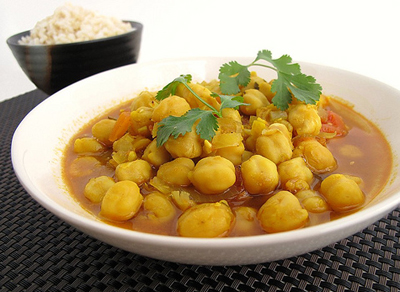 Chickpeas are among the most ancient and versatile legumes. Originating from the Middle East long before Christ, chickpeas eventually spread throughout Asia and Europe and have been a part of our diets for milennia. Popular chickpea dishes include hummus and falafel from the Middle East, roasted ceci from Italy, and besan ladoo and chana masala from India. Chickpeas can be cooked whole from dried beans, eaten fresh from the pod, dried and ground into flour, or puréed. One of my favorite Indian sweets is besan ladoo, which uses chickpea flour to create the buttery and sugary balls enjoyed as a Diwali festival dessert.
Chickpeas are among the most ancient and versatile legumes. Originating from the Middle East long before Christ, chickpeas eventually spread throughout Asia and Europe and have been a part of our diets for milennia. Popular chickpea dishes include hummus and falafel from the Middle East, roasted ceci from Italy, and besan ladoo and chana masala from India. Chickpeas can be cooked whole from dried beans, eaten fresh from the pod, dried and ground into flour, or puréed. One of my favorite Indian sweets is besan ladoo, which uses chickpea flour to create the buttery and sugary balls enjoyed as a Diwali festival dessert.
One of the easiest and most loved Indian chickpea dishes is stew. Indian chana masala is a flavorful vegetarian curry of chickpeas with a wonderful blend of Eastern spices. Indians hold chickpeas in high regard and the bean is considered to be the most widely used legume in the subcontinent. Vegetarians especially appreciate chickpeas for their nutritional value as they are high in protein and fiber. But even if you aren't a vegetarian, you too can enjoy this chickpea curry. Whether you eat it as a main dish or a side to pair with meat, this dish is completely versatile. It's easy to love and most certainly worthy of having seconds.
Global Cuisine
Global Cuisine
Manchego Cheese, Chorizo and Quince-Paste Toast with Fresh Mint
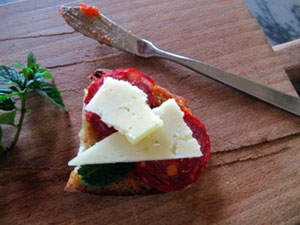 Doesn't sound very fast. Also sounds serious. Manchego y Chorizo Tapa con Membrillo Does it sound any simpler in Spanish?
Doesn't sound very fast. Also sounds serious. Manchego y Chorizo Tapa con Membrillo Does it sound any simpler in Spanish?
Let's just call it good. This crunchy, little toast is the perfect pile of salty, meaty and sweet with a jigger of freshness by way of mint leaves. The most difficult, and okay, a bit spendy, part of this tapa, is the tracking down of the fine, Spanish ingredients – Manchego, Chorizo and Membrillo (quince paste – a spicy, sweet, firm jam that is a traditional accompaniment to cheese – oh, and if you don't know what quince is....).
A cheese boutique, a Spanish specialty shop or a Fancy Food Mega Store should carry everything needed. If you live where there are no such markets, consider some click-and-spend shopping with La Espanola.(While there, order some cantimpalitos, Spanish cocktail sausages, for your next soiree – they're awesome.)
Kale Chard and Chickpea Stew with Lamb
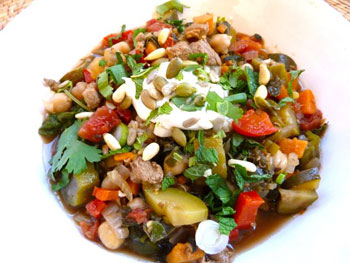 For most normal cooks, inspiration can come from just about anywhere…a restaurant, a cookbook, even a book club. But one of the consequences of being a journalist who cooks is that, occasionally, I end up “cooking the news.”
For most normal cooks, inspiration can come from just about anywhere…a restaurant, a cookbook, even a book club. But one of the consequences of being a journalist who cooks is that, occasionally, I end up “cooking the news.”
And, in 2011, as the pro-democracy movement that became known as the Arab Spring swept through North Africa and the Middle East, I ended up in the kitchen (along with Wolf Blitzer) skinny-fying a traditional dish of the region that’s now a family favorite: Kale, Chard and Chickpea Stew with Lamb over Clever Couscous.
It’s a dish that not only celebrates the rich tastes of Tunisia, it’s also rich with disease fighting and energy boosting nutrition. Already known to be a great weight loss food, chickpeas are loaded with protein, fiber and iron and–like the other fresh ingredients in this dish like sweet potatoes, zucchini, onions, chili peppers, the amazing kale, chard and the super-powered cooked tomatoes – they provide unique antioxidants that are proven to help fight heart disease and cancer.
Pantry Paella
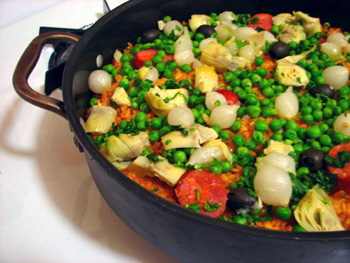 My kitchen is overflowing. My freezer is so full I can barely close it. I sometimes hear the crash of bottles, jars and tins falling off my pantry shelves and onto the floor. I seriously think I could cook and eat without going out of the house for a month. Ok, I might get bored of tuna and beans and pasta, but then again, maybe not. I have no idea what causes me to hoard food, but I sometimes imagine I must have been a starving Italian casalinga in another lifetime.
My kitchen is overflowing. My freezer is so full I can barely close it. I sometimes hear the crash of bottles, jars and tins falling off my pantry shelves and onto the floor. I seriously think I could cook and eat without going out of the house for a month. Ok, I might get bored of tuna and beans and pasta, but then again, maybe not. I have no idea what causes me to hoard food, but I sometimes imagine I must have been a starving Italian casalinga in another lifetime.
The other day I was thinking about using the short grain Valencia rice I had languishing in the cupboard to make paella. I was going to buy some shrimp but as I perused various recipes it became clear to me that you can make paella with just about any combination of vegetables, seafood or meat. There is no one paella. I figured I might as well use what I have on hand. In my pantry I had a jar of artichokes and a can of green olives, and in the freezer I had pearl onions, peas and a single sausage. Those ingredients were what I used on top of the paella rice. I tweaked the technique I found in a Mark Bittman recipe Tomato Paella to make the rice.
A Tale Of a Changed Mind. And a Burnt Tongue.
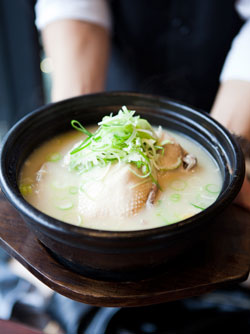 Stuffed and sated without the ability to eat even one more bite – or so I thought – we headed to Hwang Hu Sam Gye Tang restaurant to experience Samgyetang, a hot bowl of bubbling chicken soup made with one very important ingredient: ginseng.
Stuffed and sated without the ability to eat even one more bite – or so I thought – we headed to Hwang Hu Sam Gye Tang restaurant to experience Samgyetang, a hot bowl of bubbling chicken soup made with one very important ingredient: ginseng.
Ushered upstairs to the second floor of this elegant and glistening airy restaurant, we were seated next to a vast window overlooking a rainy busy side street below. We passed walls that were lined with photographs of celebrity and everyday patrons, leaving the menu to appear even that much more sparse. Hwang Hu Sam Gye Tang doesn’t offer too many things other than chicken and ginseng soup, a fact I’d later forget about once the scorching hot liquid touched my tongue.
The chef and host suggested that they bring our food to the table before cooking purely for photographic purposes. “Please, do not go through any trouble” I said to our guide, watching my translated words make their way to the chef. The chef wouldn’t have it any other way, his face said everything I needed to know. Once a boiling hot soup is brought to our table I would see none of the ingredients; steam and bubbles would make sure of that. I acquiesced and like a good guest I let them set out bowls of food to photograph.
More Articles ...
Welcome to the new One for the Table ...
Our Home Page will be different each time you arrive.
We're sure you'll find something to pique your interest...

